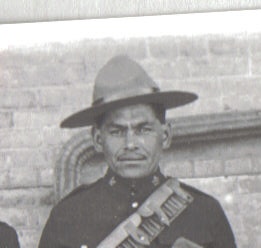Henry Norwest facts for kids
Quick facts for kids
Henry Norwest
|
|
|---|---|

Henry Norwest in 1915
|
|
| Nickname(s) | Ducky |
| Born | c. 1881 Fort Saskatchewan, Alberta District, North-West Territories, Canada |
| Died | 18 August 1918 (aged 37) Fouquescourt, Somme, France |
| Allegiance | Canada |
| Service/ |
Canadian Expeditionary Force |
| Years of service | 1915–1918 |
| Rank | Lance corporal |
| Unit | 50th Canadian Infantry Battalion |
| Battles/wars | First World War |
| Awards | Military Medal & Bar |
Henry Louis Norwest (sometimes spelled Northwest) was a brave Canadian sniper during World War I. He was known for his incredible accuracy and stealth. He earned the Military Medal and a Bar (an extra award) for his outstanding service.
Contents
Early Life and Joining the War
Henry Norwest was born around 1881 in Fort Saskatchewan, which is now in Alberta, Canada. His parents were Métis, a group of people with mixed Indigenous and European heritage. Before joining the army, Henry worked on ranches and performed in rodeos. He even served briefly with the North-West Mounted Police, which later became the Royal Canadian Mounted Police.
In January 1915, Henry decided to join the Canadian army, known as the Canadian Expeditionary Force (CEF). He first signed up as Henry Louie, but later re-enlisted under the name Henry Norwest.
A Skilled Military Sniper
Henry Norwest served for nearly three years with the 50th Canadian Infantry Battalion. He became a Lance Corporal, a junior non-commissioned officer. He was an amazing sniper, officially recorded with 115 successful shots against enemy soldiers. His true number might have been even higher, as the army only counted shots that were seen by someone else.
Henry used his skills as a hunter to become an expert sniper. He moved very quietly and used camouflage (hiding himself with natural materials) to stay hidden. Because he was so good, his commanders often sent him on reconnaissance missions. This meant he would sneak into "no man's land" (the dangerous area between enemy trenches) or even behind enemy lines to gather information.
Awards and Recognition
In 1917, Henry Norwest received the Military Medal for his bravery during the Battle of Vimy Ridge. This battle was a very important victory for Canadian soldiers. In the three months before this battle, Henry alone took out 59 enemy soldiers.
After he passed away, he was given a Bar to his Military Medal. This was a rare honor, as only about 90 soldiers in the entire Canadian Expeditionary Force received both the Military Medal and a Bar.
Henry's Last Mission
Henry Norwest was killed on August 18, 1918, just three months before World War I ended. He was on a mission to find an enemy sniper's hiding spot near Fouquescourt, France, when he was shot by that sniper.
Henry used three different rifles during the war. The second one he used is now on display at The Military Museums in Calgary, Canada. His spotter (the person who helped him find targets) brought this rifle back to Canada. It is believed that the German sniper who killed Henry took his last rifle.
Personal Life and Family
Henry Norwest was nicknamed Ducky. He was Métis, with both Cree and French heritage, and came from the Hobbema reserve in Alberta.
Henry was married and had three children. Before he joined the army, his children were sent to a residential school in Ermineskin, Alberta. His wife passed away in Alberta before he was killed in action. This meant his three daughters became orphans and spent most of their childhoods in the residential school. Henry Norwest is buried in the Warvillers Churchyard Extension Cemetery in Warvillers, France.
Legacy and Remembrance
Henry Norwest is remembered as a hero. In his hometown of Fort Saskatchewan, Alberta, there are two large stones in the cemetery with plaques that tell about his amazing achievements during the war. His name was also added to the town's cenotaph (a monument honoring those who died in war) in 2008.
The local branch of the Royal Canadian Legion, a group for veterans, has a portrait of Henry in their canteen, which is named in his honor. They also placed an eagle feather, a sacred symbol in Cree culture, in a glass case next to his picture. It is thought that Henry Norwest has hundreds of descendants today, many of whom live around the Samson Cree Nation in central Alberta.
Images for kids
-
Norwest's rifle on display at The Military Museums in Calgary.


